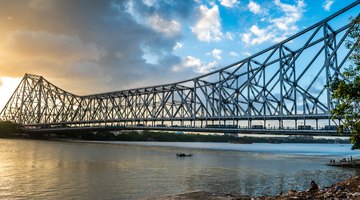How to Build a Cantilever Bridge
How to Build a Cantilever Bridge. Bridges are built in one of three main types: beam, arch and suspension.

All three types can and do incorporate cantilevers, beams supported at only one end that transfer weight to the supporting structure, thereby allowing overhanging structures without external bracing as well as longer bridges that wouldn't be possible without them. Here's how to build a cantilever bridge.
-
Measure the distance to be spanned by the bridge. This will determine first the basic bridge type called for-beam, arch or suspension-and whether the cantilevers can be connected directly to each other in a simple span or require a central truss bridge to be placed between them in a suspended span.
-
Place foundation piers to provide vertical support for the overall span. For short bridges, these are not required; however, most bridges have at least two placed at equal distances from the positions to be spanned.
-
Build cantilever arms toward the center of the span and also toward the supporting foundations at the ends of the bridge and attach them to the support piers. This is called balanced cantilever construction; the arms that extend toward the supporting foundations are called anchor arms and counterbalance the arms that extend to span the obstacle.
-
Construct support towers over the foundation piers if the bridge is long and there are only two foundation piers. This provides more strength for the supports in balanced cantilever construction.
-
Insert a central truss bridge between projecting cantilever supports if one is called for. The truss bridge may be constructed offsite and dropped in place or built onsite.
-
Attach the projecting cantilever arms to each other or the ends of the central truss bridge with connecting pins.
-
Install the roadway or railway decking, then the roadway or railway itself.
Tip
A typical beam bridge spans a distance of 200 feet, a typical arch bridge spans up to 1,000 feet, while a suspension bridge can span up to 7,000 feet. The longest cantilever bridge, the Quebec Bridge, spans 1,800 feet. While most bridges use two support piers, it is possible to use a central support pier in their place. In this case, both cantilever arms project outward from the support pier instead of being braced against support walls. This design is used in the type of suspension bridge called a cable-stayed bridge.
Warning
All bridge designs must take into account damage from the elements, as well as from traffic. Designs must avoid the possibility of crosswinds or traffic creating resonant waves within the bridge span; this caused the collapse of the original Tacoma Narrows Bridge. Typically, bridge sections include overlapping plates whose friction breaks the wave into smaller waves of different wavelengths that counteract one another.



